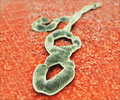Popular culture and fears of bioterrorism have stoked the public's fear of the Ebola virus, which --despite terrifying symptoms and high mortality rate -- has only taken 600 lives in 40 years.
Popular culture and fears of bioterrorism have stoked the public’s fear of the Ebola virus, which -- despite terrifying symptoms and high mortality rate -- has only taken 600 lives in 40 years.
"Other diseases like cholera or malaria, kill a lot more people in a day than Ebola has already killed" since its discovery in 1970, said Thomas Geisbert, an American army researcher who was in Libreville for an international congress on the Ebola and Marburg viruses.Ebola fever was named after a small river in what is now the Democratic Republic of Congo, where it was discovered in 1976. While extremely virulent, experts say the disease is containable because it kills its victims faster than it can spread to new ones.
Nonetheless, according to Geisbert, Ebola rose to notoriety through rumours, Hollywood films and popular fiction. The public’s fear was only made worse by the virus’ 90 percent mortality rate, he said.
"There are not many micro organisms on the planet that cause 90 percent mortality. That automatically gets interest."
But so does the literature and cinema surrounding it.
"A lot of it started when Ken Alibek, who ran the Soviet Union bioweapon program ... testified in front of the US Congress in the mid-1990s that the Russians were developing Ebola and Marburg bioweapons and when the Soviet Union dissolved nobody knew where the stuff went," said Geisberg.
Advertisement
Jean-Paul Gonzalez, research director at the Orstom development research institute and another expert on the virus, cites the film "Outbreak" as further spreading fears of the disease in the public mind.
Advertisement
"When the film came out, there was an epidemic in Kikwit (DR Congo) in 1995. The public watched this movie and then news on TV, and they saw that it was somewhat true," he said.
"When we see a woman lying on a bed and vomiting blood and a baby crying nearby, it’s an image. It sells."
After the September 11, 2001 terrorist attacks, the threat of bioterrorism added another layer to Ebola fears.
"Look at what five anthrax letters did in the United States," said Geisberg, referring to scares in the wake of September 11. "Look at the billions of dollars of impact."
Ebola could be spread quickly, according to Geisberg. If somebody had access to it, they would merely have to "put it in a bottle and kill 40 people in New York City," he said.
But if the illness has been much hyped in western society, in Africa it is a lack of information that has created problems.
"People are told they have to burn clothes, no longer bury their dead the traditional way," said Dr Jean-Jacques Mayembe, from a biomedical research institute in Kinshasa.
"We have succeeded in making people believe that Ebola is the work of witches, namely because of the spectacular effect and the vomiting of blood," said Pierre Fomenty, from the World Health Organisation.
One solution, said Mayembe, is to better inform people about the virus.
Source-AFP
SPH/L










